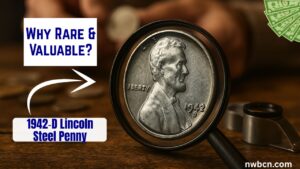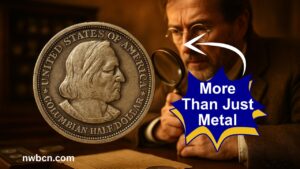The 1838‑O Capped Bust Half Dollar holds a unique place in U.S. numismatics: it was the first half dollar struck at the New Orleans Branch Mint, yet production began before the mint was fully operational.
With just 20 specimens struck, and fewer than 12 known survivors, this coin fetches $500,000 and up at auction. That it was produced amid makeshift conditions only adds to its legendary status.
The Early Days of the New Orleans Mint
- Established: Congress authorized a branch mint in New Orleans in 1835 to process southern gold and silver products, easing pressure on Philadelphia.
- Building & Equipment: The mint building and presses were completed by April 1838, with coins dies arriving in early May, including for half dollars.
- Press Issues: The large coining press malfunctioned, delaying full production. Meanwhile, a small press produced test strikes—leading to just 20 half dollars, plus a few test dimes.
- Striking debut: Despite equipment misfits, Chief Coiner Rufus Tyler improvised a die support system to strike this first issue in late January 1839, using remaining 1838-dated dies.
Ultra-Low Mintage and Survival
- Number struck: Approximately 20 proof-like half dollars, struck with special care. ([turn0search1], [turn0search9])
- Survivors today: Only fewer than 12, likely only 9–10 examples, making it among the rarest U.S. half dollars. ([turn0search1], [turn0search4])
- Proof-like quality: Often labeled “specimen” by grading services—they show sharper detail than business strikes and were never intended for circulation. ([turn0search1], [turn0search9])
Historical Significance and Collector Reverence
- First-ever half dollars struck outside Philadelphia—ushering in branch mintage at New Orleans.
- Experimental production: Reflects the challenges of establishing a mint in a major trading hub during the 1830s.
- Numismatic acclaim: Ranked among the 100 Greatest U.S. Coins (#30) by Garrett & Guth, and frequently featured in collector guides.
- Rarity factor: Many “first strikes” were quickly contested or withheld, meaning surviving examples are coveted.
Auction Records & Market Value
| Year | Grade | Sale Price (USD) |
|---|---|---|
| 2005 | Proof | $632,500 (Philadelphia-made sample) |
| 2008 | Proof | $632,500 (#2 sale) |
| Recent* | Specimen, PF64+ | $330,000–$828,000 |
| Circulated | XF to AU grade | $150,000–$300,000 estimate based on rarity |
*Estimates from NGC price guide. Precise prices vary with grade.
1838‑O Half Dollar Overview
| Feature | Detail |
|---|---|
| Mint location | New Orleans Branch Mint |
| Die date | 1838 |
| Number struck | ~20 specimen strikes |
| Surviving coins | Fewer than 12 (Proof-specimen quality) |
| Edges | Reeded edge introduced to prevent clipping |
| Composition | 89.24% silver, 10.76% copper; 13.48 g total |
| Typical sale price | $330,000–$828,000 depending on proof quality |
| Circulated example | $150,000–$300,000 (XF-AU, extremely rare) |
Why the Value Surpasses Half a Million
- Legendary rarity and provenance – among the rarest of all U.S. silver coins.
- Branch mint milestone – marks the New Orleans Mint’s initial production and expansion of federal coinage.
- Proof/specimen status – struck with intention and quality far beyond circulation strikes, and hence extremely collectible.
- Historical drama – equipment failures, yellow fever shutdowns, die compatibility issues—all add mystique.
Authentication & Grading Tips
- Certification essential: Authenticate only through PCGS or NGC to secure proper identification and date.
- Inspect die and technical details: Specimen strikes show sharp devices with lighter toning, free of circulation wear.
- Edge verification: Must have distinct reeding like later models.
- Price comparison: Use NGC, PCGS citations, and Heritage/Stack’s auctions to align with current market range.
Summary and Market Outlook
- The 1838‑O Half Dollar remains one of America’s rarest silver coins, with value grounded in historical depth, proof stature, and single-figure survivorship.
- Prices set in the $330K–$828K range for specimens, with occasional high-end coins exceeding $1 million in private sales.
- Even circulated survivors continue to drive six-figure results due to extreme rarity.
The 1838‑O Capped Bust Half Dollar is a foundational artifact of U.S. branch mint history. Struck under less-than-ideal conditions before the mint’s formal opening, its proof-specimen rarity, federal-first status, and auction records make it a pillar of numismatic prestige—earning its spot among the most sought-after coins in American collecting.
FAQs
Q1: How many 1838‑O half dollars are known today?
Experts believe fewer than 12 specimens survive—mostly in proof-like condition.
Q2: What drove the value past $500K?
Its extreme rarity, New Orleans branch-mint significance, and high-grade proof quality drive market prices well over half a million dollars.
Q3: Are there any circulated examples?
Yes, but extremely rare. XF/AU graded examples can still sell between $150,000–$300,000 due to limited survivorship.



